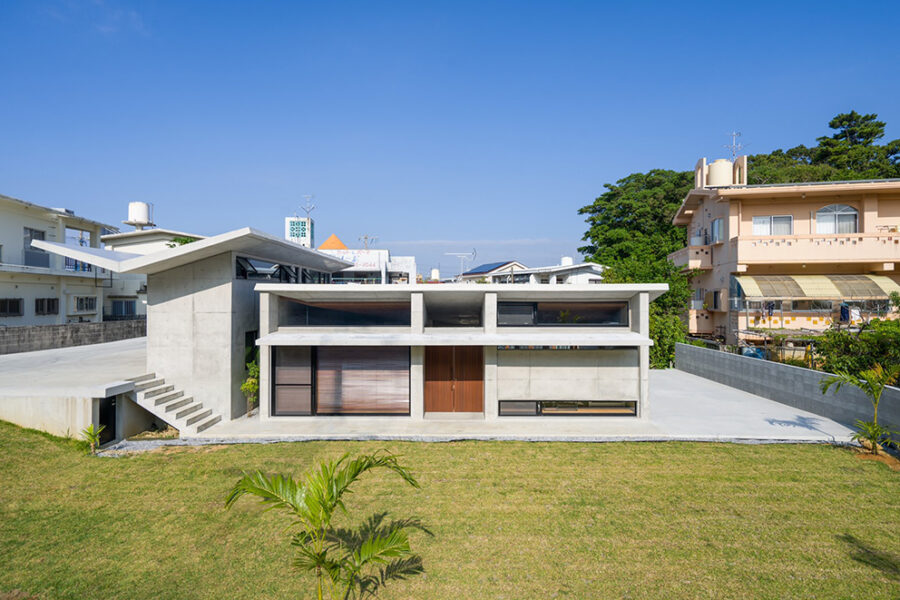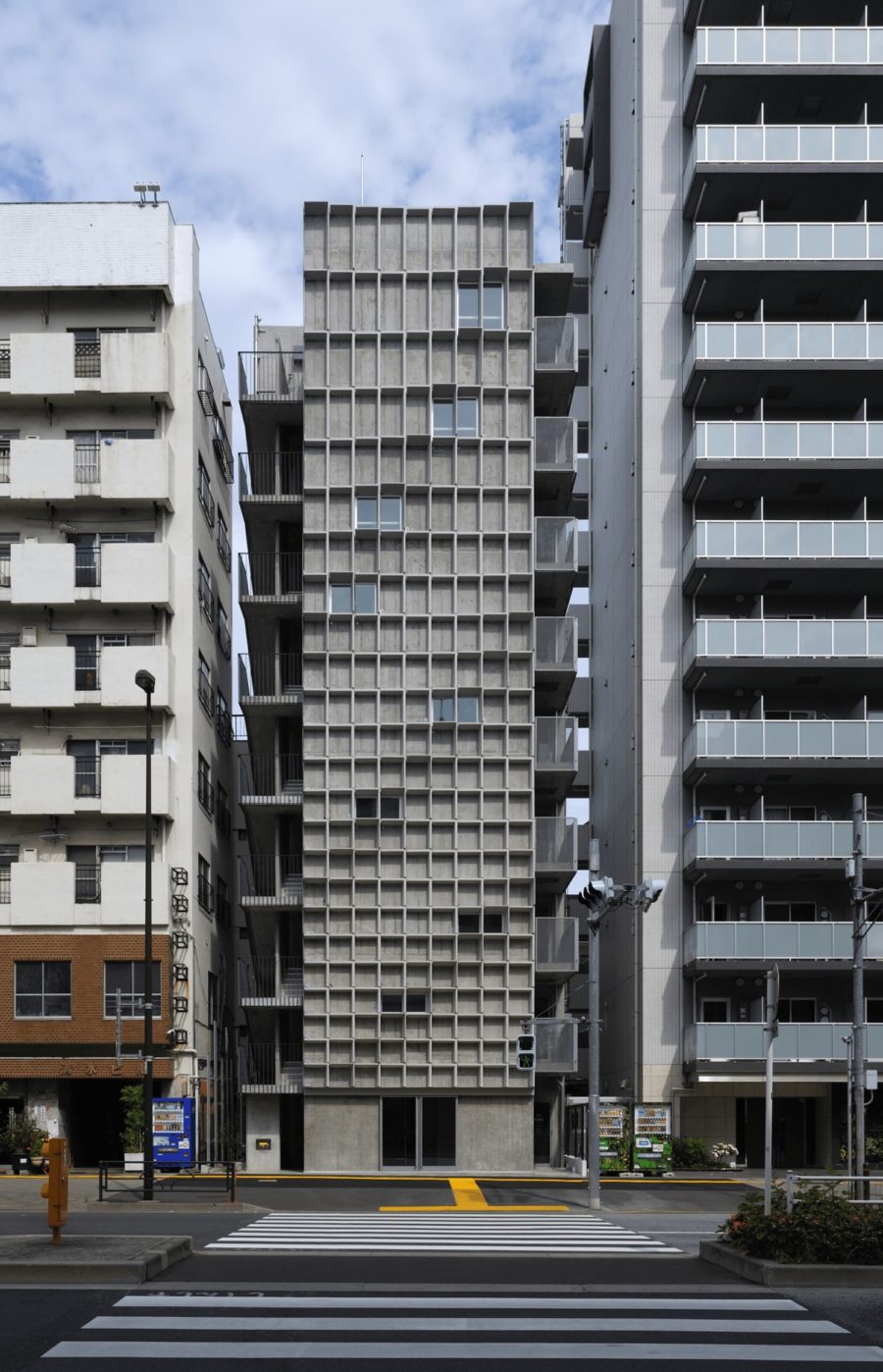クライアントは愛媛県内子町で、きらない林業/森の入り口づくりをコンセプトに地域の林業の活性化を目指す地元企業。地域木材を利用した木質資源・再生エネルギーを利用、PR、啓発・教育学習するための移動ワークスペースが求められた。そこから見えてきたのは、樹木の性質を発現する心材の魅力をどう伝えていくか、ということであった。
1. 山の未利用資源・時代遅れとなった木材資源への新しい価値付けをした商品をPRする展示・ワークショップスペース。
2. 林業を通じたプログラミング教育・脱炭素社会への再生エネルギー教育を行う教室。
彼らが取り上げる未利用資源は伐採から製材まで林業経営の中で生まれるさまざまな木材資源にはじまり、樹種は針葉樹に限らず広葉樹や低木にも及び、フレグランスをはじめとした建材以外の活用も含んだ山の資源への新しい視点が特徴的である。そこから見えてくるのは、時代と共に変わってきた社会・文化と山との付き合い方の変化であり、その姿は脱炭素や再生エネルギー・自然循環の志向とも通じる。
移動させるためのエンジンの候補として、軽トラックの利用をクライアントは提案された。理由の1つは、ゆくゆくは地域の林家さんや農家さん、アウトドアに興味がある一般層へのモバイル店舗、モバイルハウスとしての展開を見据えるためである。里山・山村で日常的に使われる軽トラックを使うことは、地域に新たな要素を差し込むことで里山の機能をアップデートすることができるという利点をもっている。
多種多様な樹種や部位に及ぶ木材を扱う彼らの活動に対して、軸となるものは何か、と考えたときに〈心材〉というキーワードが調査の中で浮かんできた。
樹種間の木材の違いは辺材部分では小さく、心材部分で大きい、という性質をもっている。
フレグランスのもととなる香りや木材の防腐機能をはじめとした各樹種の特性を示すのは、この心材部分である。樹木が同じ植物である草本類と違い大きく成長し続けられるのも、心材のおかげである。
和室が当たり前だった時代には、座敷の天井にスギの赤身無節材を貼ることが多かったが、現在ではそういった利用も廃れて一般材に混ざっていることが多くなっているそうだ。武田林業ではスギの赤身無節材を地域の製材所で選り分ける仕組みをつくり、商品化することで改めて人の目に触れる機会をつくろうとしている。
武田林業にとって、ヒノキもまた重要な素材の1つである。
創業者の祖父は四面無節のヒノキの柱材を搬出する林業家であり、その意志を引き継いで会社を興し、ヒノキ成分を利用したフレグランスや消臭スプレーの商品開発をしている。心材を表現する主要な部分を、このスギの赤身無節材で、その赤を強調するように外周部に対比させるようにヒノキを使うことが決まった。
内子小田地域は、古くは天然の広葉樹林を中心とした林業地であった。今でもこの広葉樹林は、小田深山と呼ばれる奥山へ行くときれいな紅葉の名所として残っている。広葉樹の木材もまたスギ赤身無節のように行き場を失って地域に滞留している木材の1つである。スギ赤身材と色の近いサクラ材を枠に、バッテリーボックスの収納扉兼ワークショップ用テーブルの天板をケヤキで、そして木箱の外周部のあおり板との接触部にバンパーとしてクリ材を使用し、機能によって使い分け、樹種の違いを体感できるように配慮している。
木箱の内部は幅約1.1m×奥行き約1.7m×天高約1.5mの小さな空間である。
内装はスギ赤身無節材を床壁面に使い、間近に迫るスギの板目の表情や香りを体感する場としている。天井は、ヒノキ無節材のラス板用の規格材を小幅材として加工したもの。左官・湿式施工の減少、合板の普及などで使用が減っている規格品の、武田林業による新たな利用法の提案商品である。ヒノキ白太の白さがスギ赤身の赤さを際立たせる。
上部の明かり取りには、小田の山に自生する低木のクロモジを連子窓風に使用している。クロモジはその強い香りから、古くは神事で使われていた。時代が下り茶道では楊枝や生け垣などで使われている。武田林業は、現在では未利用資源となったこの低木からフレグランスをつくることで、林家さんたちの枝打ちなどの日々の山の手入れの中に新しいメニューを提供し、山と街との繋がりを強めている。
軽トラックの積載物には地上高さ2.5m、幅を軽自動車の最大幅(1.48m)、積載荷重350kgという制限がある。そのため基本躯体は、町内で採れる比重強度の高いスギの流通規格材を骨格に、構造用合板を貼ったセミモノコック構造とした。短辺をL字の合板を挟み込み剛接合することで軽量化と剛性のバランスを取り、立面開口部のカスタム性を高めた木造の木箱としている。
積載されるボックスは軽トラックと簡易に脱着可能にし、1台の軽トラックで里山で農作業・山作業とまちへの活動の2WAYを採用可能な形式としている。ボックスは、積み込み時は軽トラックのあおり板と荷台の隙間を利用し金物で結合することで、大がかりなボルト作業などをなくし、女性でも脱着可能としている。積み込み、積み下ろしは足場用単管を利用することでコストを下げ、里山・山村で身近に手に入りやすく日常的に利用されている材料としている。
内子町は脱炭素戦略を策定し、バイオマス発電をはじめとして再生エネルギーの活用に力を入れている。
この動く木箱は、再生エネルギー普及のための啓蒙活動にも使われている。屋根には太陽光パネルを搭載して移動時も発電を行い、運転席上部に設けたバッテリーボックス内に蓄電していく。貯えられたエネルギーは再生エネルギーワークショップでの照明やドローン、ロボットの動力として利用され、再生エネルギーと生活、林業との関係を学ぶことができる。
ワークショップ、PR活動時には木箱本体に幌(ほろ)を取り付け、周囲に軒下空間を拡張し、持ち込んだ組み立て式の家具を天幕の下で展開可能としている。幌は捻り金物で簡易に脱着可能とし、組み立て式のテーブルの天板をバッテリーボックスの扉と兼用とするなど、省スペース化・設営の時間短縮へ配慮している。
自然循環の中での資源のつくり方と同時に、資源の使い方も再生エネルギー教育においては重要である。木材はその点で身近でリアリティをもった教材となる。樹木は山でその生命を終えた後、分解するまでに数十年かかると言われている。私たちはそれ以上にゆっくりと木材を使っていかなければならない。木箱では片面の鎧貼りとすることで風雨への耐候性を高め、仕様の特徴を比較できるようにしている。鎧貼りは内子小田地域の蔵の外壁に使われる知恵でもある。
日本の林業は江戸時代以来、植林を行い、世界的に見ても優れた持続可能な山との付き合い方を模索し続けてきた。しかし、高度成長期以後は木材資源を外材に依存し、生産地/山 と消費地/まちの繋がりは薄れてしまった。時代・環境の変化とともに、山がまちに求めることも、まちが山に求められる機能も変わってきている。改めて相互理解を深めるときにきている。
山で待っているだけではモノゴトは動き出さない。里山の脚である軽トラックが、山の木箱を載せて、まちへと向かう。「うごく木のわ」を回すために。(池内 健)
Mobile workspace that connects the mountains to the city and promotes wood resources and renewable energy
The client is a local company in Uchiko Town, Ehime Prefecture, which aims to revitalize the local forestry industry based on “No Cut Forestry / Creating Entrances to Forests.” A mobile workspace was required to use, promote, and educate/learn about using wood resources and renewable energy using local timber. What emerged was how to convey the appeal of heartwood, which expresses the characteristics of trees.
1. an exhibition and workshop space to promote products that add new value to the underutilized and outdated wood resources of the mountains
2. a classroom to provide programming and renewable energy education for a decarbonized society through forestry.
The unutilized resources they feature include a variety of wood resources generated in forestry operations, from logging to lumbering, and not only coniferous trees but also hardwoods and shrubs, as well as fragrances and other uses other than building materials. What emerges is a change in how society and culture interact with mountains, which has changed over time and is also consistent with an orientation toward decarbonization, renewable energy, and natural cycles.
The client suggested using a Keitruck as a candidate for the engine that would be used to move the mountain. One reason for this is to eventually develop the Keitruck as a mobile store and mobile house for local foresters, farmers, and the general public interested in the outdoors. The use of Keitrucks, which are used daily in Satoyama and mountain villages, has the advantage of updating the function of Satoyama by inserting new elements into the community.
The keyword “heartwood” came to mind during our research when we wondered what would form the axis of their activities, which involve a wide variety of species and parts of wood.
The differences in wood between species are small in the sapwood and large in the heartwood.
It is in the heartwood that the characteristics of each species, such as the fragrance that is the source of fragrance and the wood’s preservative function, are expressed. This heartwood allows trees to continue to grow, unlike herbaceous plants, which are also plants.
When Japanese-style rooms were commonplace, Japanese Cedar was often used for the ceilings of tatami rooms. Nowadays, such use has become obsolete, and the material is often mixed in with ordinary lumber. Takeda Forestry is trying to create a system whereby the local sawmills can sort out the lean, knotless lumber of cedar and commercialize it so that people can see it once again.
Hinoki (Japanese Cypress) is another important material for Takeda Forestry.
The founder’s grandfather was a forestry family that produced four-sided knotless Hinoki posts. He has continued this tradition by starting a company to develop fragrances and deodorant sprays using Hinoki components. It was decided that the main part expressing the heartwood would be made of this Japanese Cedar’s lean, knotless wood and that the Hinoki would be used to contrast the red color on the outer perimeter to emphasize it.
The Uchiko Oda area was a forestry area centered on natural broadleaf forests. Even today, these broadleaf forests can still be seen in the backcountry, called Oda-Miyama, where beautiful autumn foliage can be seen. Broadleaf lumber is another type that, like Japanese Cedar (Cryptomeria japonica D. D.), has been stagnating in the region because it has lost its way. Cherry wood, which is similar in color to Japanese Cedar (Cryptomeria japonica D. D.), is used for the frame, zelkova for the battery box door and workshop table top, and chestnut for the bumpers around the perimeter of the wooden box where it meets the roof board so that visitors can experience the difference in species by using different woods for different functions.
The interior of the wooden box is a small space measuring approximately 1.1m wide x 1.7m deep x 1.5m high.
The interior uses Japanese Cedar reddish-brown knotless wood for the floor and walls, providing a place to experience the expression and aroma of the Japanese Cedar planks up close. The ceiling comprises standard Hinoki knotless timber for lath boards, processed as small-width timbers. Takeda Forestry is proposing a new use for this standard product, which has decreased due to the decline in plastering and wet-plastering work and the spread of plywood. The whiteness of the white Hinoki logs accentuates the reddish color of the reddish Japanese Cedar.
The upper part is illuminated by a consecutive windows style window made of kuromoji, a shrub that grows naturally in the mountains of Oda. Because of its strong fragrance, kuromoji was used in Shinto rituals in ancient times. Later, the tea ceremony uses it for toothpicks and hedges. By making a fragrance from this shrub, which is now an unused resource, Takeda Forestry is providing a new menu for daily mountain tending, such as pruning branches by foresters and strengthening the connection between the mountains and the town.
There are restrictions on the load capacity of Keitrucks: height above the ground of 2.5 m, maximum width of a light vehicle (1.48 m), and a load capacity of 350 kg. Therefore, the basic frame is a Semimonocoque Construction with a frame made of Japanese Cedar, a standard material for distribution with high specific gravity strength, harvested in the town, and structural plywood attached. The short sides are rigidly joined with L-shaped plywood sandwiched between them to balance weight reduction and rigidity, and the wooden box has a customizable vertical opening.
The loaded box is designed to be easily detachable from the Keitruck, making it possible to use one Keitruck for two activities: farming and mountain work in the satoyama and activities in the town. When the box is loaded, it is connected to the Keitruck by metal hardware using the space between the Keitruck’s roof board and the cargo bed, eliminating the need for extensive bolting work and making it possible for a woman to attach and detach the box. The cost of loading and unloading the boxes is reduced by using a single pipe for scaffolding. This material is readily available in satoyama and mountain villages and is used daily.
Uchiko Town has developed a decarbonization strategy and is focusing on using renewable energy, including biomass power generation.
This moving wooden box is also used for educational activities to promote the spread of renewable energy. Solar panels mounted on the roof generate electricity even when the vehicle moves and are stored in a battery box above the driver’s seat. The stored energy is used to power lighting, drones, and robots in renewable energy workshops, allowing visitors to learn about the relationship between renewable energy, daily life, and forestry.
During workshops and PR activities, the wooden box is covered with a canopy to extend the space under the eaves around it, allowing assembled furniture to be deployed under the canopy. The canopy can be easily removed and attached with twisting hardware, and the top panel of the assembled table doubles as a door for the battery box, saving space and reducing setup time.
In renewable energy education, it is important to understand how to use resources and create resources in the natural cycle. In this respect, wood is a familiar and realistic teaching material. It is said that it takes several decades for a tree to decompose after it finishes its life in the mountains. We must use wood more slowly than that. In the wooden box, one side of the box is armor-plated to improve weather resistance and to allow comparison of the characteristics of the specifications. Armor-plastering is also the wisdom used for the exterior walls of warehouses in the Uchiko Oda area.
Since the Edo period (1603-1867), the Japanese forestry industry has continued to plant trees and seek a sustainable way to deal with superior mountains even by global standards. However, since the period of rapid economic growth, Japan has become dependent on foreign timber resources, and the connection between the production area (mountains) and the consumption area (towns) has faded. As the times and environment change, the demands of the mountains on the town and the functions of the town on the mountains have also changed. It is time to deepen mutual understanding once again.
Things do not start moving just by waiting in the mountains. Keitrucks, the legs of the satoyama, will be loaded with crates from the mountains and headed for the town. The Keitrucks will be loaded with crates from the mountains and head for the town to turn the “Moving Wood Circulation” into a movement. (Takeshi Ikeuchi)
【うごく木のわ】
用途:その他仮設施設
クライアント:武田林業
竣工:2023年
設計:studio colife3
担当:池内 健
構造設計:三野建築構造研究所
施工:武田林業、後藤建設
撮影:宮畑周平(瀬戸内編集デザイン研究所 / SETOHEN)、studio colife3
工事種別:新築
構造:木造
延床面積:2.02m²
設計期間:2023.03-2023.07
施工期間:2023.07-2023.09
【Moving Wood Circulation】
Principal use: Other temporary facilities
Client: Takeda Forestry
Completion: 2023
Architects: studio colife3
Design team: Takeshi Ikeuchi
Structural design: Mino Structural Engineers
Construction: Takeda Forestry, Goto Kensetsu
Photographs: Shuhei Miyahata / Setouchi Editorial Institute / SETOHEN, studio colife3
Construction type: New Building
Main structure: Wood
Total floor area: 2.02m²
Design term: 2023.03-2023.07
Construction term: 2023.07-2023.09








